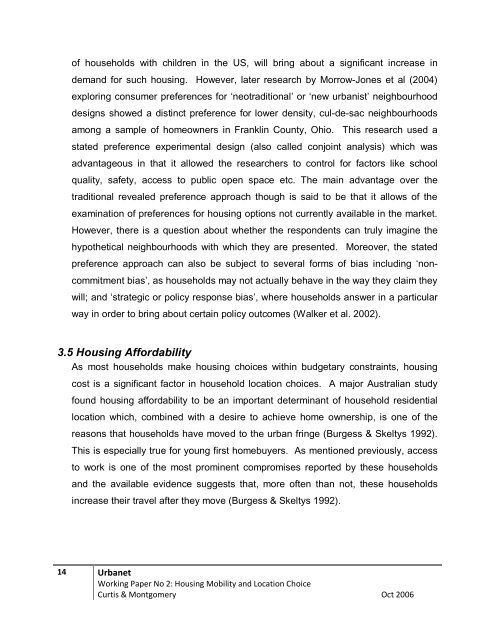Housing Mobility and Location Choice - Urbanet - Curtin University
Housing Mobility and Location Choice - Urbanet - Curtin University
Housing Mobility and Location Choice - Urbanet - Curtin University
Create successful ePaper yourself
Turn your PDF publications into a flip-book with our unique Google optimized e-Paper software.
of households with children in the US, will bring about a significant increase in<br />
dem<strong>and</strong> for such housing. However, later research by Morrow-Jones et al (2004)<br />
exploring consumer preferences for ‘neotraditional’ or ‘new urbanist’ neighbourhood<br />
designs showed a distinct preference for lower density, cul-de-sac neighbourhoods<br />
among a sample of homeowners in Franklin County, Ohio. This research used a<br />
stated preference experimental design (also called conjoint analysis) which was<br />
advantageous in that it allowed the researchers to control for factors like school<br />
quality, safety, access to public open space etc. The main advantage over the<br />
traditional revealed preference approach though is said to be that it allows of the<br />
examination of preferences for housing options not currently available in the market.<br />
However, there is a question about whether the respondents can truly imagine the<br />
hypothetical neighbourhoods with which they are presented. Moreover, the stated<br />
preference approach can also be subject to several forms of bias including ‘non-<br />
commitment bias’, as households may not actually behave in the way they claim they<br />
will; <strong>and</strong> ‘strategic or policy response bias’, where households answer in a particular<br />
way in order to bring about certain policy outcomes (Walker et al. 2002).<br />
3.5 <strong>Housing</strong> Affordability<br />
As most households make housing choices within budgetary constraints, housing<br />
cost is a significant factor in household location choices. A major Australian study<br />
found housing affordability to be an important determinant of household residential<br />
location which, combined with a desire to achieve home ownership, is one of the<br />
reasons that households have moved to the urban fringe (Burgess & Skeltys 1992).<br />
This is especially true for young first homebuyers. As mentioned previously, access<br />
to work is one of the most prominent compromises reported by these households<br />
<strong>and</strong> the available evidence suggests that, more often than not, these households<br />
increase their travel after they move (Burgess & Skeltys 1992).<br />
14 <strong>Urbanet</strong><br />
Working Paper No 2: <strong>Housing</strong> <strong>Mobility</strong> <strong>and</strong> <strong>Location</strong> <strong>Choice</strong><br />
Curtis & Montgomery Oct 2006


